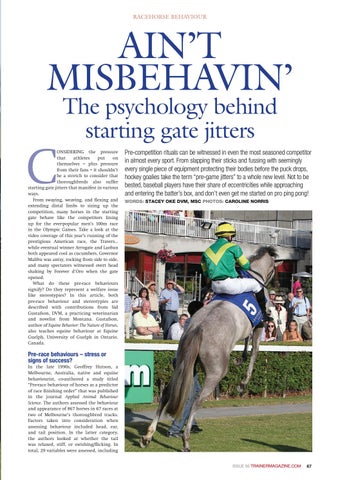RACEHORSE BEHAVIOUR
AIN’T MISBEHAVIN’
C
The psychology behind starting gate jitters
ONSIDERING the pressure that athletes put on themselves – plus pressure from their fans – it shouldn’t be a stretch to consider that thoroughbreds also suffer starting gate jitters that manifest in various ways. From swaying, weaving, and flexing and extending distal limbs to sizing up the competition, many horses in the starting gate behave like the competitors lining up for the ever-popular men’s 100m race in the Olympic Games. Take a look at the video coverage of this year’s running of the prestigious American race, the Travers… while eventual winner Arrogate and Laoban both appeared cool as cucumbers, Governor Malibu was antsy, rocking from side to side, and many spectators witnessed overt head shaking by Forever d’Oro when the gate opened. What do these pre-race behaviours signify? Do they represent a welfare issue like stereotypies? In this article, both pre-race behaviour and stereotypies are described with contributions from Sid Gustafson, DVM, a practicing veterinarian and novelist from Montana. Gustafson, author of Equine Behavior: The Nature of Horses, also teaches equine behaviour at Equine Guelph, University of Guelph in Ontario, Canada.
Pre-competition rituals can be witnessed in even the most seasoned competitor in almost every sport. From slapping their sticks and fussing with seemingly every single piece of equipment protecting their bodies before the puck drops, hockey goalies take the term “pre-game jitters” to a whole new level. Not to be bested, baseball players have their share of eccentricities while approaching and entering the batter’s box, and don’t even get me started on pro ping pong! WORDS: Stacey Oke DVM, MSc PHOtOS: caROLINe NORRIS
Pre-race behaviours – stress or signs of success? In the late 1990s, Geoffrey Hutson, a Melbourne, Australia, native and equine behaviourist, co-authored a study titled “Pre-race behaviour of horses as a predictor of race finishing order” that was published in the journal Applied Animal Behaviour Science. The authors assessed the behaviour and appearance of 867 horses in 67 races at two of Melbourne’s thoroughbred tracks. Factors taken into consideration when assessing behaviour included head, ear, and tail position. In the latter category, the authors looked at whether the tail was relaxed, stiff, or swishing/flicking. In total, 29 variables were assessed, including ISSUE 56 TRAINERMAGAZINE.COM
EUROPEAN TRAINER ISSUE 56 TAIL SWISHING.indd 81
67
22/12/2016 10:17
